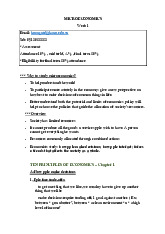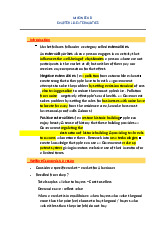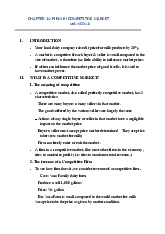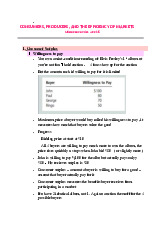





Preview text:
lOMoAR cPSD| 59114765 MICROECONOMICS WEEK 2
Interdependence and the Gain from Trade Contents
- Purposes: to demonstrate how pple can gain from trade
1. A Parable for the Modern Economy ( t ục ng )ữ
? Image there’re only 2 goods in the world, 2 pple in the world. Each ò
them would like to eat both meat & potatoes. Gains from trade are obvious if:
o The cattle rancher can produce only meat o The
farmer can produce potatoes
- Scenrio: they choose to nothing to do with each other
- Easy to see trade would allow them to enjoy greater variety: each could enjoy both meal.
- If they do both jobs: raise cattle n grow potatoes, but one is better
producing 1 job. Each would benefit by specilizing in what he like to do .
- But, when 1 person is better at producing everygood . Should the
rancher choose to remain self-sufficient ?
Production Possibility
Suppose: the farmer & rancher work 8h/ day ( 1 oz = 28,35 gram ) lOMoAR cPSD| 59114765
Specialization and Trade
If the farmer and rancher choose to be self-sufficient rather than trade with
each other, then each consumes exactly what he or she produces. In
this case, the production possibilities frontier is also the consumption
possibilities frontier. That is, without trade, Figure 1 shows the possible
combinations of meat and potatoes that the farmer and rancher can
each produce and then consume.
- These production possibilities frontiers are useful in showing the trade-
offs that the farmer and rancher face, but they do not tell us what the
farmer and rancher will actually choose to do.
- To determine their choices, we need to know the tastes of the farmer and
the rancher. Let’s suppose they choose the combinations identified by
points A and B in Figure 1: The farmer produces and consumes 16 ounces
of potatoes and 4 ounces of meat, while the rancher produces and
consumes 24 ounces of potatoes and 12 ounces of meat.
- After several years of eating combination B, the rancher gets an idea and
goes to proposes a trade to a the farmer
+ Farmer stops producing meat & devote ful 8h a day growing potatoes
+Rancher spend 6h a day rasising cattle n 2h frowing potatoes lOMoAR cPSD| 59114765
2. Comparative Advantage : The Dricing Force of
Specialization ( l ợi ích so sánh )
The farmer doesn’t seem to do anything best.
? Who can produce the potatoes at a lower cost – the farmer or the rancher 2 possible answers:
- Way 1: compare inputs requires by 2 producers Have absolute
advantage ( ability to produce a good using fewer inputs than another producers )
+ In our ex, cost measured by time. The rancher requires less time than
the farmer Rancher has absolute advantage in producing both potatoes
n meat, measuring cost by quantity of input ( time ) lOMoAR cPSD| 59114765
- Way 2: compare oppornity cost ( whatever must be given up to obtain some item )
+ Ex: assume rancher & farmer each spends 8h/day working ( time to
produce potatoes + time to produce meat = 8h more time produce
potatoes, relatively less time ro produce meat: 4+4=8, if spend 5 produce
potatoes, have only 3h left to produce meat or vuce versus, etc.)
+ The opportunity cost measures the trade-off between the two goods
that each producer faces. Measure cost of 1 good with quantity of
another good. ( Measure potato cost with quantity of meat produced in that 10 min, taken away )
Farmer’s OC: 1 oz potatoes = 0,25 oz meat
Rancher’s OC: 1 oz potatoes = 0,5 oz meat o Comparative Advantage
- Comparative Advantage: the ability to produce a good at a lower
opportunity cost than another producer - In our example,
Conclusion: It’s possible for 1 person to have an absolute advantage in
both gods but impossible to have a CA in both goods
CA reflects the relative opportunity cost. Unless 2 pple have exactly the
same opportunity cost ( 1 person’ll have a CA in 1 good, the other
person will have a CA in the other good )
- Farmer has a CA in growing potatoes
- Rancher has a Ca In producing meat
o Comparative Advantage and Trade lOMoAR cPSD| 59114765
- The gains from specialization and trade are based on comparative
advantage, NOT on absolute advantage
- When each person specializes in producing the good for which he or she
has a comparative advantage, total production in the economy rises.
- This increase in the size of the economic pie can be used to make everyone better off.
- In our example, the farmer spends more time growing potatoes, and the
rancher spends more time producing meat. As a result, the total
production of potatoes rises from 40 to 44 ounces, and the total
production of meat rises from 16 to 18 ounces.
Trade can benefits everyone insociety bcs it alow pple too specialize
in the activitues in which they have a comparative advantage. o The Price if Trade
- General rule: for both parties to gain from trade, this price must lie between 2 opportunity costs.
- In our example, the farmer and rancher agreed to trade at a rate of 3
ounces of potatoes for each ounce of meat. This price is between the
rancher’s opportunity cost (2 ounces of potatoes per ounce of meat) and
the farmer’s opportunity cost (4 ounces of potatoes per ounce of meat).
The price need not be exactly in the middle for both parties to gain, but it
must be somewhere between 2 and 4.
- If price od meat <2 oz of potatoes
+ Consequences: both of them want to buy meat
+ Reason: the price’s be lower than their opportunity costs
- If price of meat > 4 oz of potatoes
+ Consequence: both would want to sell meat
+Reason: the price get higher than their OC
Each of them specialize in the good that he has CA, and as a resuly they are better-offf.
3. Applications od Comparative Advantage
Should Tom Brady mow his own lawn? lOMoAR cPSD| 59114765
- Do it himself : 2hour . In that 2 hour, he can earns $20.000
- Forrest Gump: do in 4hour. In that 4h, he work n earn $40
Both of them better-off when Brady hire Gump pay $40< x< $20.000]
Should the US trade with other countries ?
- Suppose 2 countries: US n JP & 2 goods : foods n cars . US has more land -
> better producing food / JP = US in produing car
- Opportunity cost of a car : JP JP should produce more car than it wants
for own use n export some of them to US.
- US has CA in producing foods US should produce more foods than it
wants dor own usw n export to JP
- Through specialization & trade, both countries can have more food and more cars. SUMMARY
There’re 2 ways to compare the ability of 2 pple in producing a good
- The one who can produce good with smaller quantity od inputs is said to
have an absolute advantafe in producing the good
- The person who has the smaller opportunity cost of producing the good is
said to have a comparative advantage.
The gains from trade are based on comparative advantage, not absolute advantage.
• Trade makes everyone better off because it allows people to specialize
in those activities in which they have a comparative advantage.
• The principle of comparative advantage applies to countries as well as
to people. Economists use the principle of comparative advantage to
advocate free trade among countries.
PROBLEMS N APPLICATION (1,2,3,6,8 )



